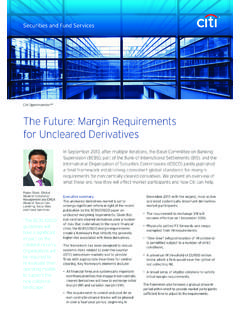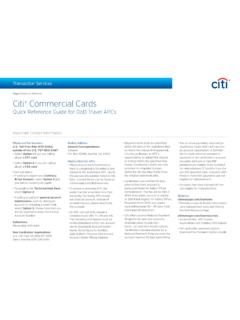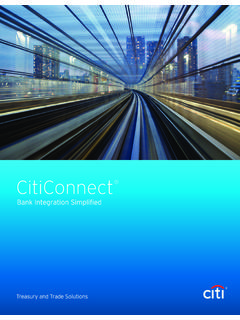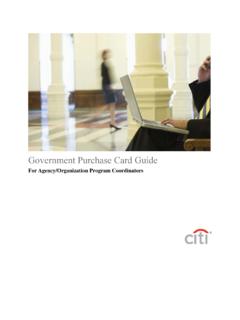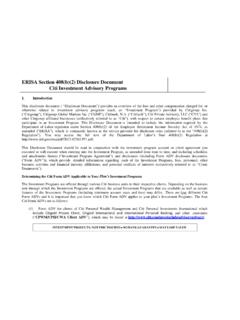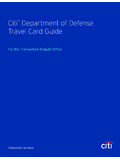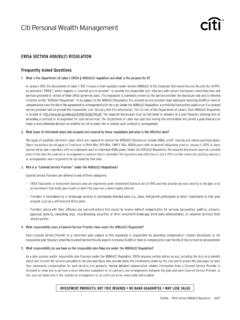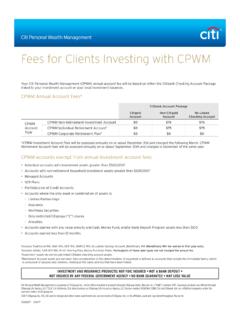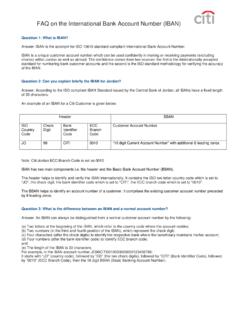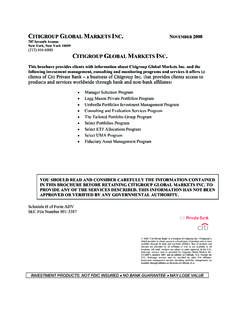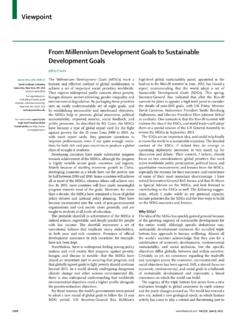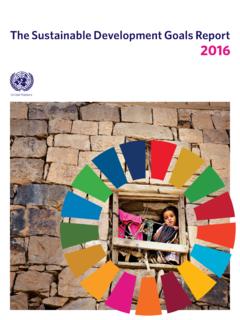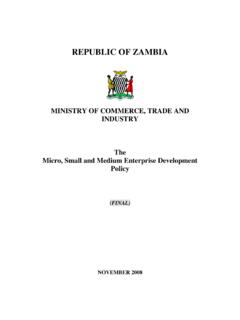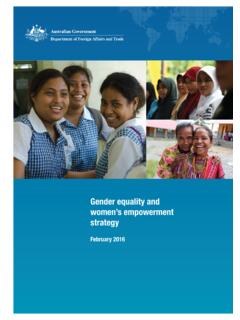Transcription of UNITED NATIONS SUSTAINABLE DEVELOPMENT GOALS
1 Citi is one of the world s largest financial institutions, operating in all major established and emerging markets. Across these world markets, our employees conduct an ongoing multi-disciplinary conversation accessing information, analyzing data, developing insights, and formulating advice. As our premier thought leadership product, Citi GPS is designed to help our readers navigate the global economy s most demanding challenges and to anticipate future themes and trends in a fast-changing and interconnected world. Citi GPS accesses the best elements of our global conversation and harvests the thought leadership of a wide range of senior professionals across our firm. This is not a research report and does not constitute advice on investments or a solicitations to buy or sell any financial instruments.
2 For more information on Citi GPS, please visit our website at NATIONS SUSTAINABLE DEVELOPMENT GOALSP athways to Success A Systematic Framework for Aligning InvestmentCiti GPS: Global Perspectives & Solutions June 2018 Citi GPS: Global Perspectives & Solutions June 2018 Jason Channell Head of Social & Responsible Investment Research +44-20-7986-8661 | Elizabeth Curmi Global Thematic Analyst +44-20-7986-6818 | Zoe Whitton Head of Australian ESG Research +61-2-8225-4811 | Edward McKinnon Australian ESG Research +61-2-8225-4898 | Tina M Fordham Chief Global Political Analyst +44-20-7986-9860 | Contributors Rupert Rink Ying Qin Catherine Leigh Cunningham June 2018 Citi GPS.
3 Global Perspectives & Solutions 2018 Citigroup 3 UNITED NATIONS SUSTAINABLE DEVELOPMENT GOALS Pathways to Success A Systematic Framework for Aligning Investments Although there is much in the world to be proud of, we still face enormous societal, environmental, and economic challenges. Even in this day and age, more than 2 billion people a quarter of all humankind lack access to even the most basic elements of life that most of us take for granted, such as clean water, sanitation, and energy, while 800 million people more than one in ten of us remain undernourished. At its most extreme, the picture is infinitely worse; 700 million people, again, almost one in ten of us, still live below the poverty line on less than $ per day, a sum that many of us spend on a coffee without a second thought.
4 More than 40% of children younger than age 14 (800 million) still lack access to a 'complete' education, and are denied the opportunity to reach their full potential. Beyond the obvious impact on their own lives, what benefits might almost a billion extra well-educated people bring to the world? The 17 UNITED NATIONS SUSTAINABLE DEVELOPMENT GOALS aim to tackle the challenges, issues, and injustices facing the world by 2030, but the GOALS themselves are complex. They are arguably all inextricably linked, with numerous feedback loops, not all of them positive. Trillions of dollars of capital wants to invest sustainably but struggles to translate an investment philosophy, which desires alignment with the SDGs, into a practical investment strategy given that complexity.
5 This report tries, as far as possible, to simplify the SDGs to examine those interlinkages, to determine the driving forces and resulting benefits, and thereby determine a set of critical paths our so-called 'pathways to success' which can lead quickly and most effectively to the achievement of the GOALS . It allows us to identify who is best placed to do what, from the public sector to the private sector to the investment community, and what their route in might be. We examine the GOALS individually, attempting to lay out both the incremental financial cost/opportunity of achieving the goal, and the human benefit that might be gained by solving it. In a world of scarce resources, it also provides an indication of which paths might achieve the broadest human benefit for the least financial cost though this does not mean these are the most important it is not by accident that all roads on our 'pathways to success' lead to the eradication of poverty.
6 We identify incremental physical investment needs or opportunities in water, energy, and the circular economy alone of $ trillion per year, while social investment areas of education, health, and hunger add up to an annual incremental opportunity of $800 billion. To be sure, these are enormous sums, but much smaller than the sums of capital looking to invest sustainably and tiny in relation to the human benefits that could be achieved. We also examine the innovative financial instruments and frameworks needed to allow that capital to flow to aid in the achievement of the GOALS . The SDGs represent the challenge of our generation but a challenge which we should embrace, as the benefits for those suffering most, as well as to the whole global community, would be immeasurable if we were to succeed.
7 By identifying the lowest hanging fruit, the feedback loops, the critical paths, the scale of the opportunity in both human and financial terms, and who might do what, we hopefully break the sometimes daunting SDGs down into a roadmap a framework which allows all elements of society, from policymakers, to corporates and the financial community, to set out in partnership down a pathway to a better, fairer, wealthier, more inclusive, cleaner, and more SUSTAINABLE world that we can be truly proud to leave for our children. 2018 CitigroupA Framework for investing in the UN SDGsThe first step to building a framework for investing in the SDGs is to group them together by primary area of focus, then try to break down whether it is a cause or an effect.
8 Affordable and Clean EnergyClean Water and SanitationResponsible Consumption and ProductionSustainable Cities and CommunitiesCAUSELife Below WaterLife on LandClimate ActionGood Health and Well-being Zero Hunger Quality EducationNo Poverty Peaceful and Inclusive Societies Reduced Inequalities Gender EqualityIndustry, Innovation and InfrastructureDecent Work and Economic GrowthEnvironmental/PhysicalEconomicEnvi ronmental/PhysicalEconomicSocialSocialEF FECTSDG1 SDG2 SDG3 SDG4 SDG5 SDG6 SDG7 SDG8 SDG9 SDG10 SDG11 SDG12 SDG13 SDG14 SDG15 SDG16 Next, we identify the linkages and interaction between the different SDGsSDG1 SDG2 SDG3 SDG4 SDG5 SDG6 SDG7 SDG8 SDG9 SDG10 SDG11 SDG12 SDG13 SDG14 SDG15 SDG16 Environmental/PhysicalSocialEconomicNega tive or postiveNegativeStrongModerateStrongModer ateStrongModerateA Framework for investing in the UN SDGsInvestment opportunities Recycling Waste minimization Waste management Energy from waste Renewable energy Energy efficiency Energy storage Water treatment Sanitation Desalination Distribution networks Transportation Telecommunication Research and DEVELOPMENT Private education On-line learning Educational infrastructure Educational media Pharmaceuticals Biotech e-doctors
9 Agricultural technology FertilizersSource: Citi Research, UNITED NationsCombining the two, we can derive a series of critical pathways for SDGs Citi GPS: Global Perspectives & Solutions June 2018 2018 Citigroup 6 Contents Introduction to the SDGs 7 What Are the SDGs? 7 Section 1: Examining the UN SUSTAINABLE DEVELOPMENT GOALS 10 How Do Investors Use the SDGs? 11 Pathways to Success 15 Impact and Opportunity 25 Making it Happen 35 Summary and Conclusions 43 Section 2: The 17 UN SDGs 47 SDG 1: No Poverty 48 SDG 2: Zero Hunger 53 SDG 3: Good Health and Well-Being 59 SDG 4: Quality Education 64 SDG 5: Gender Equality 68 SDG 6: Clean Water and Sanitation 75 SDG 7: Affordable and Clean Energy 80 SDG 8: Decent Work and Economic Growth 85 SDG 9: Industry, Innovation, and Infrastructure 91 SDG 10: Reduced Inequalities 95 SDG 11: SUSTAINABLE Cities and Communities 102 SDG 12: Responsible Consumption and Production 108 SDG 13: Climate Action 114 SDG 14: Life Below Water 119 SDG 15: Life on Land 124 SDG 16.
10 Peace, Justice, and Strong Institutions 129 June 2018 Citi GPS: Global Perspectives & Solutions 2018 Citigroup 7 Introduction to the SDGs What Are the SDGs? The UN SUSTAINABLE DEVELOPMENT GOALS (SDGs) were put in place in 2015 to take up the baton from where the UN s Eight millennium DEVELOPMENT GOALS (MDG's) left off, and to finish what they did not achieve. The SDGs consist of 17 GOALS which aim to address, by 2030, the biggest challenges facing society, the planet, and humankind or as the UN puts it, 'People, Planet, Prosperity': People: 'We are determined to end poverty and hunger, in all their forms and dimensions, and to ensure that all human beings can fulfil their potential in dignity and equality and in a healthy environment.
